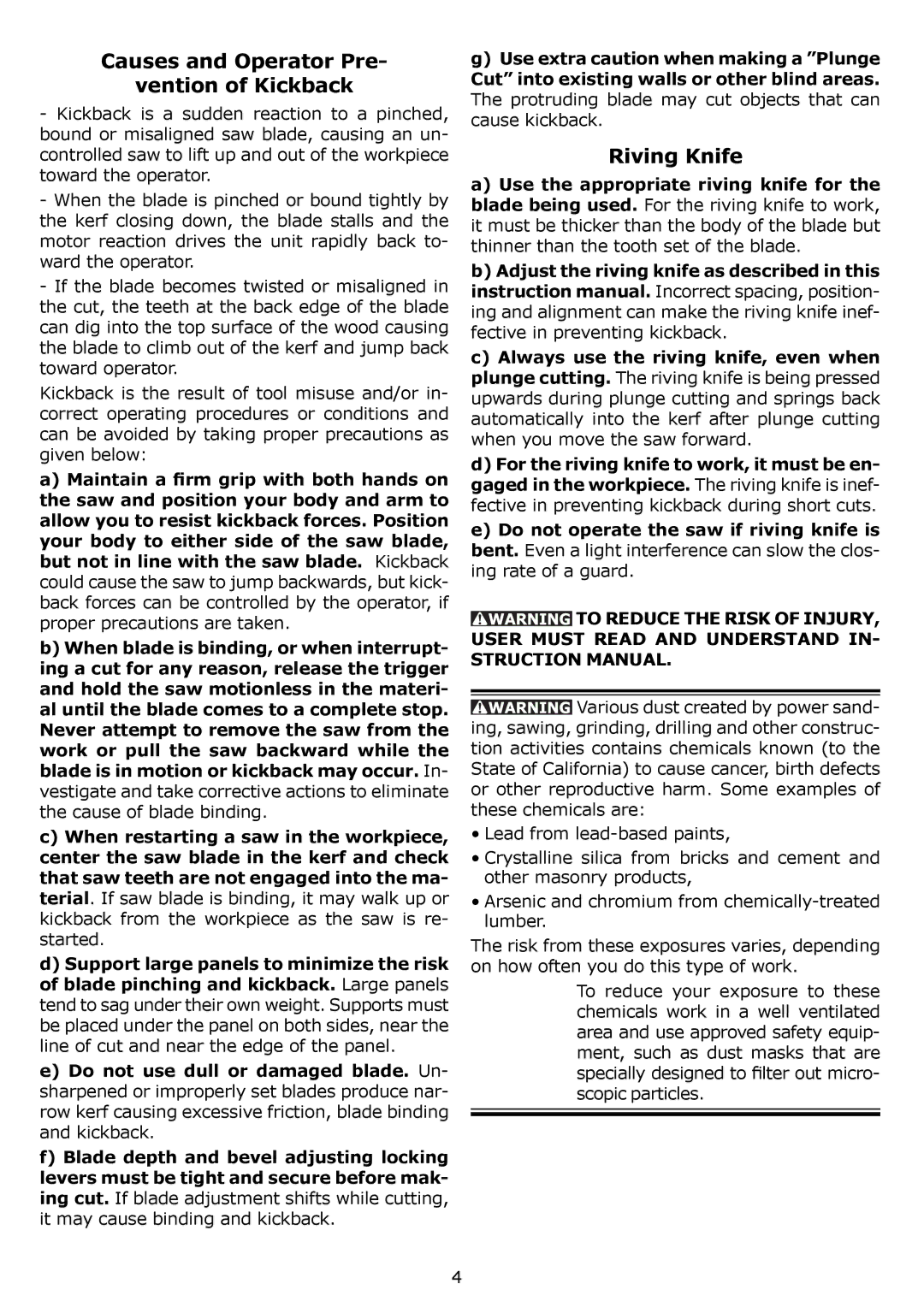
Causes and Operator Pre-
vention of Kickback
-Kickback is a sudden reaction to a pinched, bound or misaligned saw blade, causing an un- controlled saw to lift up and out of the workpiece toward the operator.
-When the blade is pinched or bound tightly by the kerf closing down, the blade stalls and the motor reaction drives the unit rapidly back to- ward the operator.
-If the blade becomes twisted or misaligned in the cut, the teeth at the back edge of the blade can dig into the top surface of the wood causing the blade to climb out of the kerf and jump back toward operator.
Kickback is the result of tool misuse and/or in- correct operating procedures or conditions and can be avoided by taking proper precautions as given below:
a)Maintain a firm grip with both hands on the saw and position your body and arm to allow you to resist kickback forces. Position your body to either side of the saw blade, but not in line with the saw blade. Kickback could cause the saw to jump backwards, but kick- back forces can be controlled by the operator, if proper precautions are taken.
b)When blade is binding, or when interrupt- ing a cut for any reason, release the trigger and hold the saw motionless in the materi- al until the blade comes to a complete stop. Never attempt to remove the saw from the work or pull the saw backward while the blade is in motion or kickback may occur. In- vestigate and take corrective actions to eliminate the cause of blade binding.
c)When restarting a saw in the workpiece, center the saw blade in the kerf and check that saw teeth are not engaged into the ma- terial. If saw blade is binding, it may walk up or kickback from the workpiece as the saw is re- started.
d)Support large panels to minimize the risk of blade pinching and kickback. Large panels tend to sag under their own weight. Supports must be placed under the panel on both sides, near the line of cut and near the edge of the panel.
e)Do not use dull or damaged blade. Un- sharpened or improperly set blades produce nar- row kerf causing excessive friction, blade binding and kickback.
f)Blade depth and bevel adjusting locking levers must be tight and secure before mak- ing cut. If blade adjustment shifts while cutting, it may cause binding and kickback.
g)Use extra caution when making a ”Plunge Cut” into existing walls or other blind areas. The protruding blade may cut objects that can cause kickback.
Riving Knife
a)Use the appropriate riving knife for the blade being used. For the riving knife to work, it must be thicker than the body of the blade but thinner than the tooth set of the blade.
b)Adjust the riving knife as described in this instruction manual. Incorrect spacing, position- ing and alignment can make the riving knife inef- fective in preventing kickback.
c)Always use the riving knife, even when plunge cutting. The riving knife is being pressed upwards during plunge cutting and springs back automatically into the kerf after plunge cutting when you move the saw forward.
d)For the riving knife to work, it must be en- gaged in the workpiece. The riving knife is inef- fective in preventing kickback during short cuts.
e)Do not operate the saw if riving knife is bent. Even a light interference can slow the clos- ing rate of a guard.
![]()
![]()
![]()
![]() TO REDUCE THE RISK OF INJURY, USER MUST READ AND UNDERSTAND IN- STRUCTION MANUAL.
TO REDUCE THE RISK OF INJURY, USER MUST READ AND UNDERSTAND IN- STRUCTION MANUAL.
![]()
![]()
![]()
![]() Various dust created by power sand- ing, sawing, grinding, drilling and other construc- tion activities contains chemicals known (to the State of California) to cause cancer, birth defects or other reproductive harm. Some examples of these chemicals are:
Various dust created by power sand- ing, sawing, grinding, drilling and other construc- tion activities contains chemicals known (to the State of California) to cause cancer, birth defects or other reproductive harm. Some examples of these chemicals are:
•Lead from
•Crystalline silica from bricks and cement and other masonry products,
•Arsenic and chromium from
The risk from these exposures varies, depending on how often you do this type of work.
To reduce your exposure to these chemicals work in a well ventilated area and use approved safety equip- ment, such as dust masks that are specially designed to filter out micro- scopic particles.
4
